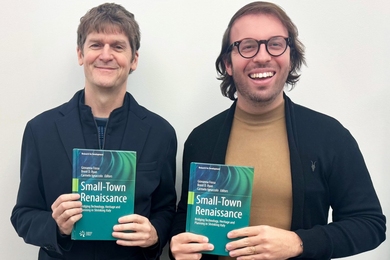ATLANTA--NASA's Chandra X-ray Observatory has revealed an expanding ring-like structure of oxygen and neon that was hurled into space by the explosion of a massive star. The image of E0102-72 provides unprecedented details about the creation and dispersal of heavy elements necessary to form planets like Earth.
The results were reported by Professor Claude Canizares of the Massachusetts Institute of Technology (MIT), Cambridge, at the 195th national meeting of the American Astronomical Society in Atlanta, Ga. Drs. Kathryn Flanagan, David Davis, and John Houck of MIT collaborated with Canizares in this investigation.
E0102-72 is the remnant of a supernova explosion located in our neighbor galaxy, the Small Magellanic Cloud, nearly 200,000 light years away. It was created by the explosion of a star that was more than ten times as massive as our Sun. We are seeing the aftermath of the explosion a thousand or more years after the outburst. Shock waves are heating gas to temperatures of nearly 10 million degrees, so it glows with X-rays that are detected by Chandra's instruments.
By using the High Energy Transmission Grating Spectrometer (HETG), astronomers were able to pinpoint the distribution of each chemical element individually and measure the velocities of different parts of the expanding ring. They also show the shock wave in a kind of "freeze-frame," revealing the progressive heating of the stellar matter as it plows into the surrounding gas. This is the first time such detailed X-ray information has ever been obtained for a supernova remnant, and should provide critical clues to the nature of supernovae.
The grating spectrometer, which was built by an MIT team led by Canizares, spreads the X-rays according to their wavelength, giving distinct images of the object at specific wavelengths characteristic of each chemical element. Small wavelength shifts caused by the Doppler effect are used to measure the expansion velocities of each element independently.
"We've been studying these supernova remnants for decades, but now we're getting the kind of information we need to really test the theories," said Canizares.
"Understanding supernovae helps us to learn about the processes that formed chemical elements like those which are found on Earth and are necessary for life" said Flanagan.
Most of the oxygen in the universe, for example, is synthesized in the interiors of relatively few massive stars like the one being studied here. When they explode, they expel the newly manufactured elements which become part of the raw material for new stars and planets. The amount of oxygen in the E0102-72 ring is enough for thousands of solar systems.
By measuring the expansion velocity of the ring, the team can estimate the amount of energy liberated in the explosion. The expansion energy would be enough to power the sun for 3 billion years. The ring has more complex structure and motion than can be explained by current simplified theories, suggesting complexity in the explosion itself or in the surrounding interstellar matter.
The supernova remnant also provides a laboratory for atomic physics. The observations show how the atoms in the expelled matter behave when heated to such high temperatures. The images reveal the progressive stripping of electrons from the atoms after the super-sonic shock wave has passed.
The Chandra observation was taken using the HETG in conjunction with the Advanced CCD Imaging Spectrometer (ACIS) on September 28 and October 10, 1999. ACIS was built by Pennsylvania State University, University Park, and the Massachusetts Institute of Technology, Cambridge.
To follow Chandra's progress, visit the Chandra site at: http://chandra.harvard.edu> and http://chandra.nasa.gov>
NASA's Marshall Space Flight Center in Huntsville, Ala., manages the Chandra program. TRW, Inc., Redondo Beach, Calif., is the prime contractor for the spacecraft. The Smithsonian's Chandra X-ray Center controls science and flight operations from Cambridge, Mass.
Additional contacts:
Steve Roy, Marshall Space Flight Center, Huntsville, AL, Phone: 256-544-6535 http://www.msfc.nasa.gov/news>
Dr. Wallace Tucker, Chandra X-ray Observatory Center, Harvard-Smithsonian Center for Astrophysics Cambridge, MA, Phone: 617-496-7998
Barbara Kennedy, Penn State PIO, University Park, PA, Phone: 814-863-4682, Email:





